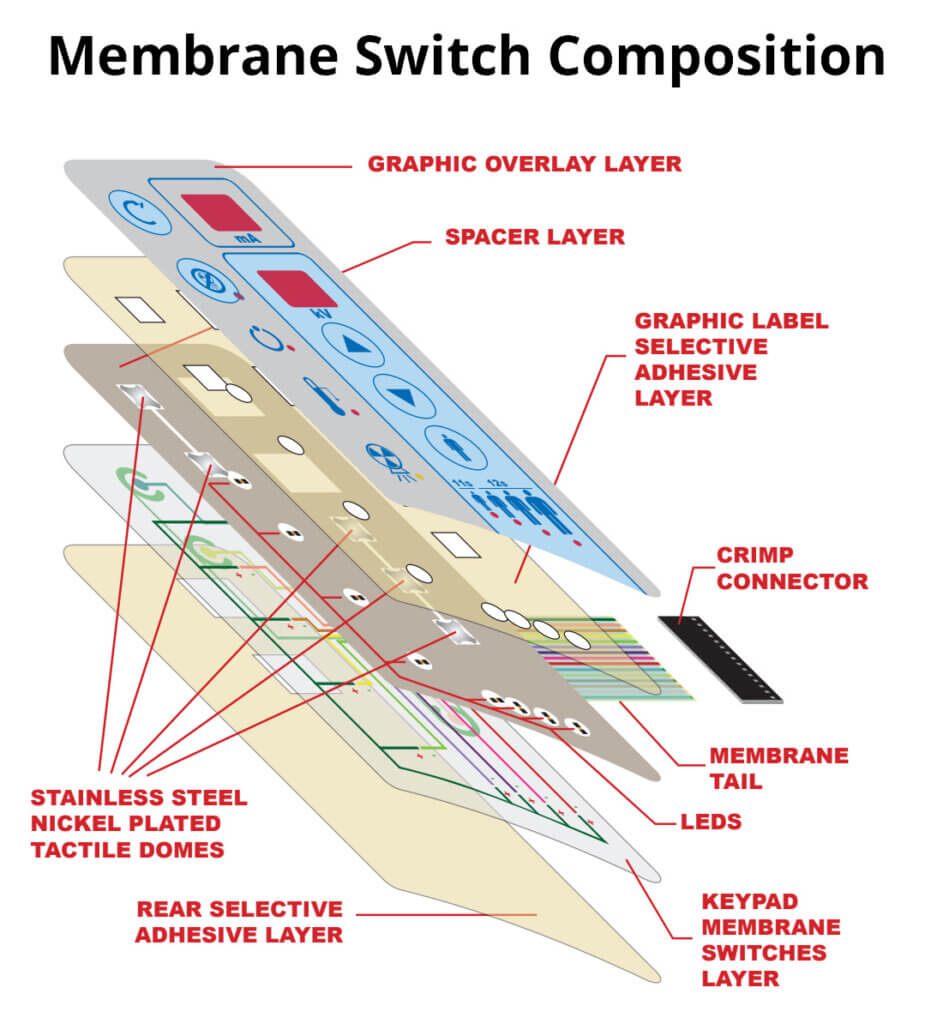Understanding Membrane Layer Switches Over: The Secret to Long Lasting and Trusted Controls

What Are Membrane Switches?
Membrane switches are an advanced solution in the world of interface innovation, integrating performance and style effortlessly. These tools act as an interface between customers and electronic systems, integrating several components right into a portable layout. Usually created from versatile, slim layers of materials, membrane switches are developed to react to touch, allowing individuals to communicate with machinery and electronic devices properly.
The primary aspects of a membrane switch include a published circuit layer, graphic overlay, and a spacer layer that stops unintended activation. The visuals overlay can be tailored to show brand identity or user choices, boosting aesthetics while ensuring use. Membrane layer switches are commonly made use of in different applications, including clinical gadgets, consumer electronics, and commercial devices, owing to their toughness and resistance to environmental factors such as dampness and dust.
One of the key benefits of membrane layer buttons is their capability to stand up to deterioration, making them perfect for high-traffic settings. Furthermore, they are lightweight and need very little space, permitting for ingenious layouts in product development. Overall, membrane layer switches stand for a efficient and practical selection for modern digital interfaces, marrying modern technology with user-centric design concepts.
How Membrane Layer Switches Job
The procedure of membrane layer switches over hinges on a basic yet efficient system that converts customer input into electronic signals. When a user presses the button, the top layer deforms, enabling a conductive aspect in the circuit layer to make call with an equivalent conductive pad on the bottom of the graphic overlay.
The style of membrane layer buttons can differ, however they usually incorporate domes or responsive elements to supply comments to the individual, boosting the total experience - membrane switch. The materials made use of in membrane layer buttons, such as polyester or polycarbonate, add to their sturdiness and resistance to environmental factors, including moisture and dirt. The published circuits are commonly encapsulated, which protects them from wear and tear over time.
Advantages of Membrane Layer Buttons

Furthermore, membrane switches are known for their durability. Constructed from robust materials, they are resistant to dirt, dampness, and physical wear, which significantly prolongs their life-span compared to traditional mechanical switches. This durability makes them particularly suitable for high-traffic settings and applications calling for long life.
An additional substantial advantage is the simplicity of cleaning and maintenance. The smooth surface area of membrane changes minimizes dirt buildup and is usually impervious to spills, making them perfect for settings that need frequent sanitization.
Moreover, membrane layer buttons use a streamlined profile, leading to a thinner layout that can be incorporated into various devices without including mass. This feature not just improves the aesthetic allure yet likewise contributes to an extra ergonomic item design.
Applications of Membrane Layer Switches
Straightforward and flexible, membrane buttons find applications throughout a large range of markets, including clinical devices, customer electronics, and commercial tools. In the clinical area, these switches are essential to tools such as diagnostic tools, client surveillance systems, and infusion pumps, where integrity and ease of cleansing are crucial. Their capacity to endure rough atmospheres and keep performance makes them perfect for such applications.

In consumer electronics, membrane switches are made use of in items like microwaves, washing devices, and remotes - membrane switch. Their sleek style allows for user-friendly individual interfaces, boosting the overall user experience while offering durability and resistance to tear and wear
Industrial devices additionally gains from membrane layer buttons, specifically in over at this website control panels for machinery and automation systems. These switches provide security versus dirt and dampness, ensuring regular efficiency in tough environments. Their customizable features allow producers to tailor them to specific operational demands, boosting efficiency and functionality.
Picking the Right Membrane Layer Switch Over
When picking a membrane switch, it is necessary to consider various variables that affect efficiency and suitability for specific applications. The key factors to consider include ecological conditions, tactile comments, longevity, and design requirements.
First, assess the operating setting; switches revealed to wetness, chemicals, or extreme temperatures require details materials to make certain longevity and capability. my blog Next off, review the demand for tactile feedback. Depending upon customer interaction, some applications might profit from a responsive action to verify activation, while others might choose a non-tactile design for visual reasons.
Resilience is an additional vital element; membrane layer buttons ought to be developed to stand up to constant use, impacts, and abrasion. Ensure the chosen button can endure the anticipated lifecycle, particularly in high-usage situations.

Verdict
Finally, membrane switches offer as important parts in the layout of trustworthy and long lasting control systems throughout various sectors. Their portable style, integrated with robust building and adjustable features, improves user interaction while making certain durability in requiring atmospheres. The convenience of membrane layer switches enables tailored options that fulfill particular functional needs, enhancing their importance in modern-day technology. As sectors remain to progress, the significance of incorporating effective membrane layer button remedies can not be overstated.
Membrane layer switches over represent a crucial element of contemporary interface style, mixing performance with durability in different applications.Membrane layer buttons are an advanced option in the realm of customer interface technology, combining functionality and design perfectly. Generally built from adaptable, slim layers of products, membrane my review here layer buttons are developed to respond to touch, enabling users to interact with equipment and digital tools successfully.
The design of membrane layer buttons can differ, however they frequently incorporate domes or tactile components to give comments to the individual, enhancing the total experience.In verdict, membrane changes serve as important parts in the layout of long lasting and trustworthy control systems throughout different markets.